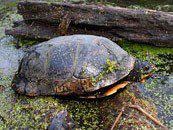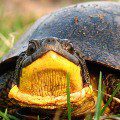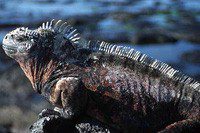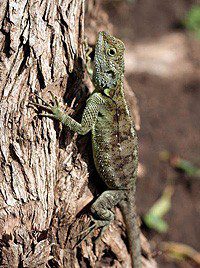
American bog turtle
This is a medium-sized turtle with an average carapace length of 25 to 27 cm. The carapace itself is dark olive in color, covered with light small spots. The ventral shield is most often a lighter shade. The female has a wider and longer carapace than the male. In adults, the carapace is extremely mobile and can be pulled up so that the anterior and posterior openings of the shell with the limbs retracted are tightly closed. Because of these abilities, the American bog turtle is often called the “semi-box turtle”.
This turtle is omnivorous, but its main diet is crustaceans and insects.
Mating takes place between March and October. The male uses various ways to attract the attention of the female, the favorite of which is to release the systems of water from the mouth and nostrils, while getting into the female’s physiognomy. During pregnancy, the female switches to a terrestrial lifestyle, and in order to find the right place for laying, she can travel long distances. The American bog turtle lays eggs once a year. The incubation period lasts from 48 to 82 days at a temperature of 27 to 29 degrees. The offspring are born weighing about 10 grams and about 3,5 cm in length.
To keep this turtle, a horizontal type aquaterrarium with a volume of 150 liters or more is suitable. It must be filled with distilled tap water. The average daily temperature should be from 30 to 32 degrees, water temperature in the range from 20 to 23 degrees. This turtle can hibernate both at low and at high temperatures. Hibernation spends both under water and on land, buried in the ground. Young animals will need to eat daily, adults are fed two to three times a week. In addition to the main diet, turtles will need to be given mineral and vitamin supplements.
The meat of the American marsh turtle is considered tasty and is actively eaten.
Other names
Emydoidea blandingii, Blanding’s turtle.
Inhabitation
 The American marsh turtle is distributed from the South of Ontario through all the Great American Lakes to the west to the states of Nebraska, Iowa, in the northeast of Missouri. Individual populations are also found in eastern New York, Mena, Nova Scotia, and southern New Hampshire.
The American marsh turtle is distributed from the South of Ontario through all the Great American Lakes to the west to the states of Nebraska, Iowa, in the northeast of Missouri. Individual populations are also found in eastern New York, Mena, Nova Scotia, and southern New Hampshire.
Like the European marsh turtle, this turtle is common in low-flowing shallow water bodies, it can often be found on land, where it not only basks in the sun, but also earns its own food. In the daytime, if it rests or hunts in the water, it floats to the surface about every 15-20 minutes in order to stock up on air. In one of the ongoing experiments, cases were identified when turtles survived in conditions where the water temperature was reduced to 18 degrees, and, at the same time, there was no air access for two days.
Reservoirs this turtle prefers small, with abundant vegetation and a muddy bottom. In the water, the turtle moves extremely dexterously and quickly enough, dives and swims remarkably well, and can remain under water for a long time without surfacing.
Description
In size and coloration, the American marsh tortoise resembles the European marsh tortoise. On average, its size is 25-27 cm.
Carapace of the same dark olive color with light small spots and, usually lighter, ventral shield. The carapace of the female is wider and longer than the carapace of the male. Compared to the European bog turtle, the American bog turtle has a more convex carapace, and the spots and dots, especially in juveniles, are bright yellow.
In adults, in the transverse ligament, the carapace is so mobile that it can be pulled up in such a way that the posterior and anterior openings of the carapace are tightly closed when the limbs are retracted. Because of this ability, the American bog turtle is sometimes called the “semi-box turtle”. Her lower jaw is bright yellow. Females have a longer plastron and carapace, as well as a wider body than males. The throat and lower jaw are yellow in females, black in males.
The plastron of the American bog turtle is pale yellow in color, covered with black-brown spots, while it has a so-called “hinge” that is located between the ventral and pectoral scutes, and which does not physically close, although it is similar in appearance to that of box turtles .
Food
The diet of this turtle is quite diverse, but the main food is insects and crustaceans. She also eats earthworms, tadpoles, slugs, mollusks, beetles, snails. She eats fish, but in relatively small quantities. The same is true with plant foods.
Reproduction
The mating process in this species can be observed from March to October during the entire active period. Males attract in a variety of ways, one of the most common being to swing their heads from side to side when near a female. And the most inventive way of seduction is to release jets of water from the nostrils and mouth, which fall exactly into the physiognomy of the female.
During pregnancy, the female American bog turtle moves to a terrestrial lifestyle and, in search of a place to lay eggs, can travel long distances. In June, the female makes a clutch, which consists of 10-14 eggs. In September, offspring hatch from them, which will remain underground until the onset of spring. The laying itself takes place once a year.
The incubation period lasts from 48 to 82 days at a temperature of 27-29 degrees. Most often, at a temperature of 22 to 27 degrees, males are born, and at a temperature of 28-31 degrees, females appear. During the incubation period, it will be necessary to maintain a high, over 90% humidity, otherwise there is a high risk of the masonry drying out.
Babies are born about 3 cm long and weigh about 5 grams.
Content
 For the American marsh turtle, you will need a horizontal type aquaterrarium, with a volume of 150 liters or more per one or two individuals. The recommended proportions for an aquaterrarium are two-thirds water and one-third land. You also need to take into account that the turtle is growing, so the size of the terrarium should be selected with a margin. Water for an aquaterrarium is suitable for settled tap water. Fresh water should not be poured, as it is saturated with chlorine and is too cold. Most of the water needs to be changed at least once a week, as the turtle pollutes it a lot. A complete cleaning of the aquaterrarium is carried out monthly.
For the American marsh turtle, you will need a horizontal type aquaterrarium, with a volume of 150 liters or more per one or two individuals. The recommended proportions for an aquaterrarium are two-thirds water and one-third land. You also need to take into account that the turtle is growing, so the size of the terrarium should be selected with a margin. Water for an aquaterrarium is suitable for settled tap water. Fresh water should not be poured, as it is saturated with chlorine and is too cold. Most of the water needs to be changed at least once a week, as the turtle pollutes it a lot. A complete cleaning of the aquaterrarium is carried out monthly.
Above the shore should be located downward, local heating (mirror lamp or incandescent lamp). In the daytime, under heating, the average temperature should be up to 30-32 degrees, the water temperature is on average 20-23 degrees. If the temperature regime is violated, the turtle may hibernate. At a temperature of 25 degrees, the turtle stops eating, and when it reaches 30 degrees, the turtle can hibernate in summer. Turtles can maintain some activity even at a temperature of only 10 degrees, however, when it drops to 13 degrees, the American marsh turtle most often becomes lethargic and hibernates at the bottom of the aquaterrarium. Sometimes it hibernates on land, after digging into the soil.
In principle, the presence of soil on the shore is not necessary, however, coarse sand, gravel, coconut substrate with sphagnum on top can be used, while it will need to be moistened periodically. In the pond itself, you need to place a lot of aquatic plants and stones, however, you need to keep in mind that their size must be large enough so that the turtle cannot swallow them. In any case, a large piece of land will be required. The water level in the aquarium should be such that the turtle can swim freely in it, but could not get out of it. Too much difference between land and water should not be done. As for the soil in general, there is one more nuance – the turtles still litter their habitat quite strongly, so recently terrariumists are increasingly abandoning the soil in favor of rugs imitating grass. Such a “grass” can be attached with special glue to the bottom, the island itself or the ladder, and it is also very convenient to clean it.
When picked up, she can hiss for a long time, like a snake.
As for feeding, young animals should eat daily, while adults eat two to three times a week. The amount of food is distributed in such a way that the turtle copes with it in 20-30 minutes. Some terrarium keepers put the turtle in a separate container for feeding time to avoid excessive pollution in the aquaterrarium. In addition to the main nutrition, do not forget about mineral and vitamin supplements. They will need to be fed to the turtle once a week. As for dry food, it is recommended to give them to the turtle not too often, and then as a top dressing.
Aquaterrarium equipment will require a heater, an external filter and a reptile UV lamp.
In general, keeping an American bog turtle is not their easy process, so it is clearly not suitable for beginner terrariumists. Although, despite the strictest conservation measures in relation to this species in the United States, this turtle has a lot of “admirers” among experienced hobbyists.
Additionally
This turtle is named after the oldest American naturalist, William Blading of Philadelphia, who studied the animal world of America during the development of the continent.
Turtle meat of this species is considered very tasty. Local residents eat it and organize trade.
Although the American bog turtle is not at risk of extinction, it is listed by the World Conservation Union (IUCN) as a low risk species.
Sources of
http://www.floranimal.ru
http://www.cherepahi.ru
http://www.publicant.ru
http://zoodv.ru
http://www.rocka.ru





